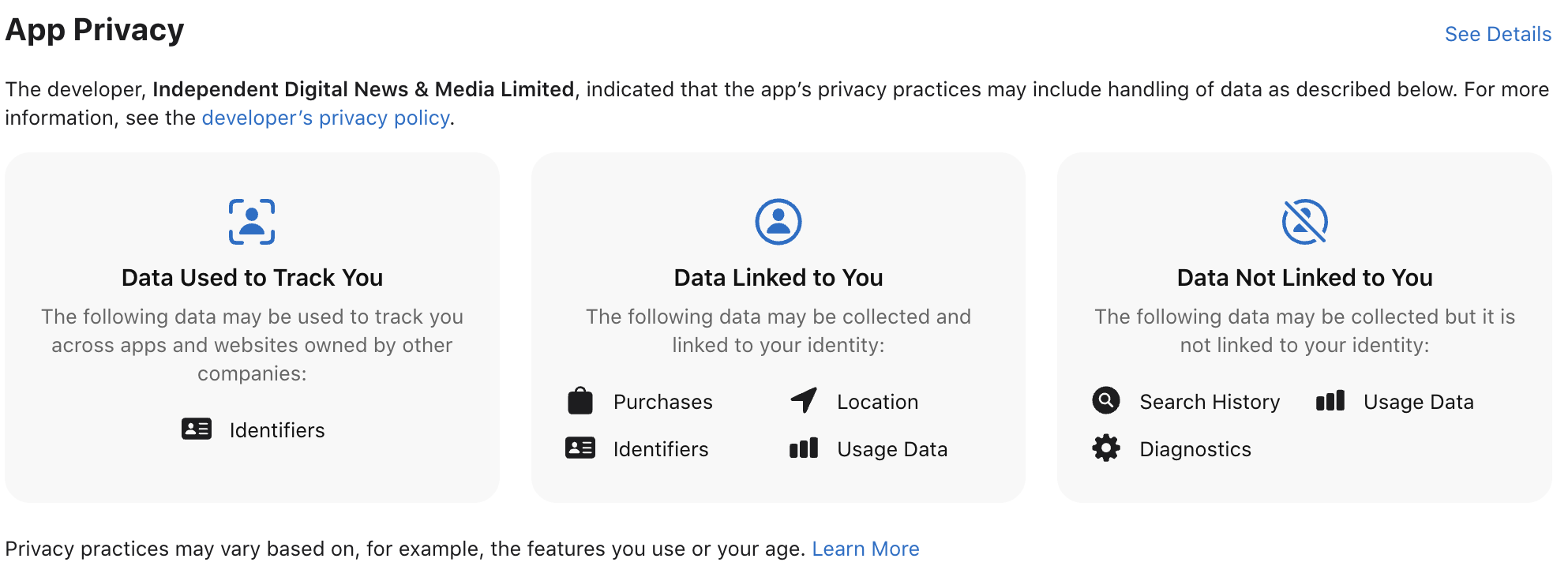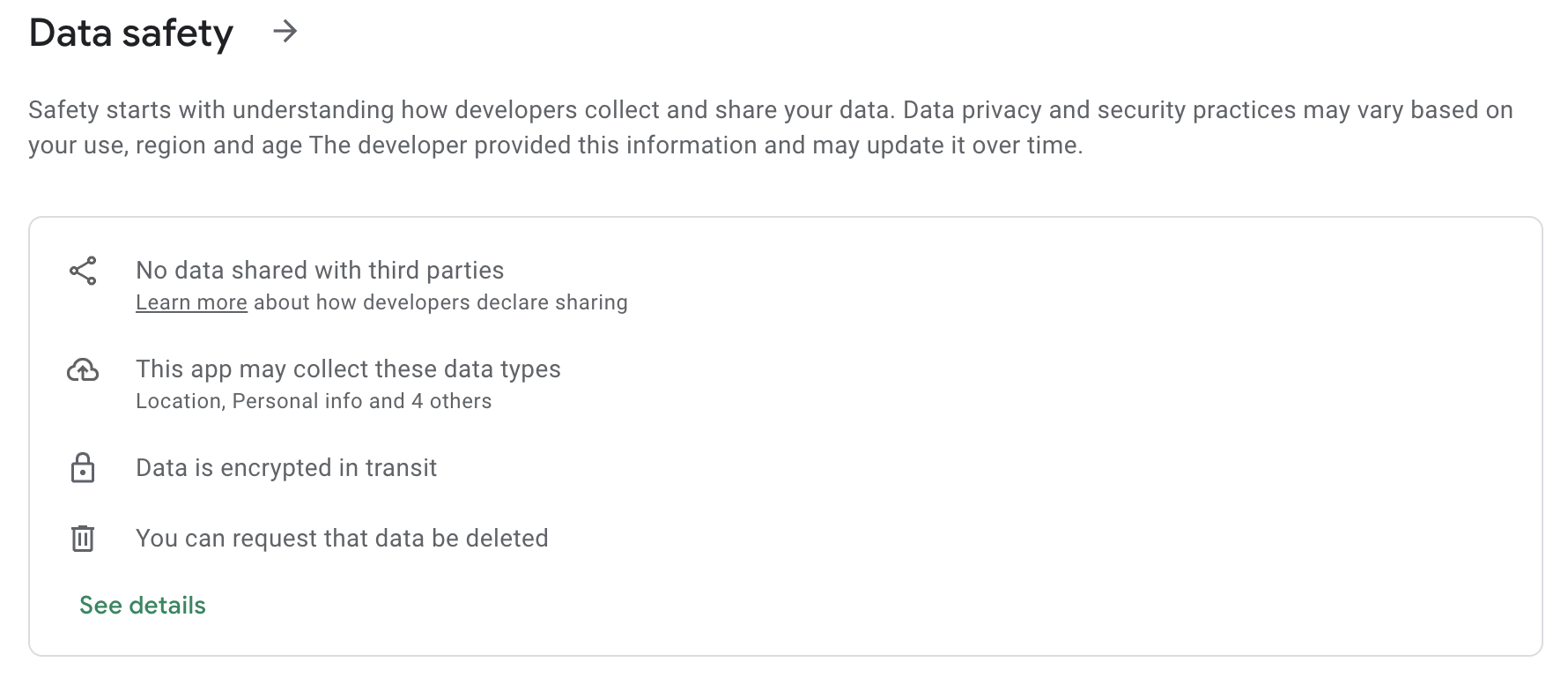Data Consent & App Tracking Transparency
Table of Contents
The ever-entwined concepts of tracking and user consent are always evolving, but recent years and months have seen sweeping changes that have substantially raised the bar in terms of what publishers and developers need to do.
Any app submission now requires that you fully disclose what information is captured about your users, and how you intend to use that data. As part of the app submission process you must complete an App Privacy report for iOS and a Data Safety report for Android. These reports are visible to the user.
 Sample iOS App Privacy report
Sample iOS App Privacy report Sample Play Store Data Safety report
Sample Play Store Data Safety report
This document explains your Pugpig app's capabilities for collecting user data and giving users control over the data that is being collected about them. We strive to make it as easy possible for your apps to attain and maintain compliance with the applicable laws and guidelines.
What Pugpig does or is doing
- We have added the ability to support Consent Management Platform (CMP) SDKs across our app platforms. Supported CMP SDKs must adhere to the IAB Tech Lab's CMP API specifications, which standardise the representation of consent signals from users. It is the responsibility of tracking technology providers, such as the analytics SDKs we include in our app products, to be compatible with the appropriate CMP APIs and to respect the consent signals provided.
- Supports Apple's App Tracking Transparency framework. This is an iOS-level feature that requires users to explicitly opt in to any tracking that can be used to measure them across multiple properties. This largely applies to Apple's (ID for Advertisers) IDFA. Our app products will display the necessary prompt to users and pass on either a valid or empty IDFA dependent on the user's choice. See more below on ATT.
- Maintain our supported SDKs to ensure we are making best efforts to use versions that are compliant.
- Offer an out-of-the-box global opt-in flow for users of your apps. This allows users to make a decision about their tracking choices upon opening the app, and to change that decision by visiting the app settings.
Users are able to
- Make choices regarding the level of data they want to share, and update these choices at any time.
- Understand these choices by accessing privacy policies and other relevant information within the app.
What data Pugpig collects
- While our app products include rich tracking solutions that can be integrated with virtually any analytics platform of your choosing, none of this data is actually stored by Pugpig. Our apps simply collect this data and pass it on to the analytics provider.
- We do not use the IDFA, or any consistent identifier, for any purpose of our own. The IDFA will only be utilised by SDKs that ask for it, and only if the user has opted-in to sharing it.
- Data transferred when a user logs in is passed between the app, our distribution service and your authorisation service, but not stored by us.
SDK support
A key feature of the Pugpig platform is our ability to integrate with the analytics and push notification services of your choosing. Usually by implementing the service's SDK in the app code. It is the responsibility of the service and their SDK to ensure that they aren't breaching compliance by collecting data the user hasn't agreed to. Our role is to ensure the SDK knows what the user's decisions are.
App Tracking Transparency
App Tracking Transparency (ATT) is a feature of iOS introduced in iOS 14.5. Its aim is to give users more control over the ability of developers, publishers or marketers to track them across multiple properties. Until now, the IDFA (Identify for Advertisers) was a consistent identifier that allowed marketers to develop a holistic view of a user's behaviour across all apps the marketer had access to.
While the IDFA is not going away, users will now be asked when first-opening an app that wants to use the IDFA whether they want the developers of this app to be able to track them across other apps or websites. The assumption is that the opt-in rate to these prompts will be very low, thus rendering the IDFA largely useless.
If a user does opt out, the IDFA will simply be passed as a string of zeroes. It will also be just zeroes in the period before the user is presented with the prompt to opt-in.
So how does this play with Pugpig? We will implement the ATT framework, making our apps compliant and allowing the user to opt-in to tracking. We'll then pass their choice to any tracking SDKs looking to utilise the IDFA. In time we'll integrate this with the consent UI mentioned above, allowing publishers to explain to the user why they should choose to opt-in before showing the opt-in prompt.
Again, several SDKs require updates to function optimally in an ATT world. We'll update all of our supported SDKs to the required versions.
What this means for you is that any marketing activities focused on data derived from the IDFA are likely to see a substantial decrease in volume as users begin to opt out. This will begin as soon as users update to iOS 14.5 and see the opt-in prompt.


